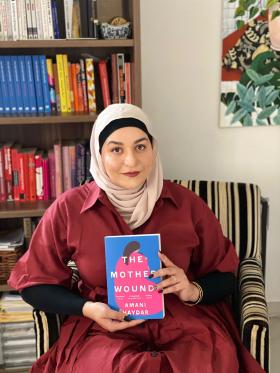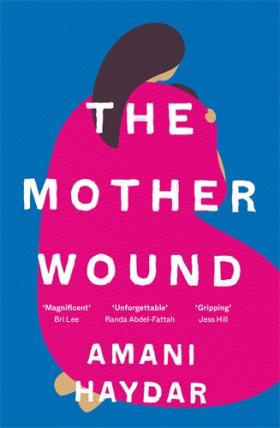Q&A with Amani Haydar
Lawyer, artist and women’s advocate Amani Haydar honours her mother’s life in her new memoir.
What does it mean to you to have your mother’s story published? (Amani’s mother, Salwa, was murdered in 2015 by her husband, Amani’s father.)
It’s huge. I’ve carried this story in my heart for years now and to be able to share it after so much reflection, with this level of detail, feels like both a triumph and a relief. It is also a bittersweet experience because it is a story I wish I didn’t have to tell. I feel a deep sense of responsibility sharing Mum’s experiences with the world but I’m looking forward to seeing what conversations will emerge from this work and how it will contribute to ongoing discussions about women’s safety in Australia.
What surprised you, if anything, while recording the audiobook?
I was surprised at how hard it can be to read out loud! It was a tedious process at times, but I think the final product is so worthwhile. We’ve also included something really special in the audio that I think will be incredibly moving for listeners. I have a whole new appreciation for audio as an artform.

Both! A painting can sometimes inspire a new writing breakthrough and writing can sometimes inspire a painting. I see both mediums as part of my creative process. For me, they sit together like a picture book; some things are best said in an image, others need to be articulated and processed in writing. I approach both intuitively and generally prioritise whatever project is calling to me with the most urgency.
You have said that you paint a portrait of yourself at least once a year. What have you learnt about yourself over time?
I’ve been doing this since I entered the Archibald Prize in 2018 — that’s four large self-portraits. I have learnt that self-perception is a fluid thing that is heavily influenced by our environment and political context. I see some strong parallels between self-portraiture and memoir; they both demand that we look inwards and interrogate inconsistent, unresolved feelings as well as reflect on our context and surroundings.
How important is it for you to collaborate with other writers and artists?
I love collaborating with other creatives. Maintaining a creative practice is otherwise incredibly solitary! My favourite collaboration to date was part of an exhibition of my work at the Peacock Gallery in Auburn in 2019. I collaborated with MsSaffaa, a paste-up mural artist, to develop a mural using some of my illustrations. I loved learning about her process of turning small drawings into large prints and the techniques she uses to assemble the images into huge collage-like murals. Our mural included poetry by Phoebe Grainer, which I painted onto the wall by hand, and our catalogue included an essay by Maryanne Taouk.
The Mother Wound has been described as ‘a stunning feminist memoir’. How do you see your relationship to feminism?
My relationship with feminism has evolved a lot since I was younger. For me, feminism provides a framework and a lens with which to understand and analyse my experiences and ways of thinking that can help us solve problems. I am mindful of the ways that mainstream feminist literature has often left out the voices of Indigenous women, migrant women and other marginalised groups. My approach is to think of feminism as a vehicle for justice; if it’s not helping us achieve justice and equality for the most marginalised groups, then who is it serving? How do we make our feminist projects better and more inclusive?
Has there been a recognisable shift in the way domestic violence is talked about in a cultural, societal or legal setting?
I believe the shift has mostly happened in public discourse and this has begun to create legal change. As recently as June 2021, following an enquiry, a NSW Parliamentary Committee found that coercive control should be criminalised. There are some important critiques and reservations around this and it will be interesting to observe what overall impact the laws will have for survivors. It will change the way we think about abuse, allowing the law to identify patterns of abuse rather than just one-off incidents.
What questions aren’t being asked and should be?
How do we create systems that empower and centre the voices of victims in a way that focuses on healing and recovery? How do we challenge one-size-fits-all responses by governments and other institutions? How do we respond to urgent, individual concerns and needs while also challenging structural issues and keeping in mind the bigger picture? Why do we find it easier to accept state-sanctioned forms of violence than interpersonal violence?

The process isn’t linear, but I would love to see more consistent funding for organisations that provide trauma-informed services to survivors of violence. Whatever we do next needs to be intersectional, survivor-lead and community oriented. I would love to see more preventative work being done with young people in schools to empower them to challenge sexism as well as identify different forms of abuse in their own lives.
As a mother, sister, artist, writer, lawyer and advocate, what are you most proud of?
I’m proud of my mum and the way she navigated barriers in her life. I am proud of my sisters who have been consistent in their support and continue to achieve their personal goals. I am proud to be telling Mum’s story and my Teta’s (grandmother's) story and honouring their lives.
What will you do next?
I’ll be making some art for a couple of upcoming projects over the next few months. I’ll also be writing a contribution for an upcoming anthology, presently titled Another Australia. My next big goal is to finish my master’s degree and write a novel. I’ve wanted to push myself creatively and write fiction for a while and I think I can do that now that I’ve finished The Mother Wound.
Amani Haydar’s The Mother Wound is available online through the Library Shop.
This Q&A appeared in Openbook Spring 2021.